
The Rubik's Cube is a 3D combination puzzle invented in 1974 by Hungarian sculptor and professor of architecture Ernő Rubik. Originally called the Magic Cube, the puzzle was licensed by Rubik to be sold by Pentangle Puzzles in the UK in 1978, and then by Ideal Toy Corp in 1980 via businessman Tibor Laczi and Seven Towns founder Tom Kremer. The cube was released internationally in 1980 and became one of the most recognized icons in popular culture. It won the 1980 German Game of the Year special award for Best Puzzle. As of January 2024, around 500 million cubes had been sold worldwide, making it the world's bestselling puzzle game and bestselling toy. The Rubik's Cube was inducted into the US National Toy Hall of Fame in 2014.

The Rubik's Revenge is a 4×4×4 version of the Rubik's Cube. It was released in 1981. Invented by Péter Sebestény, the cube was nearly called the Sebestény Cube until a somewhat last-minute decision changed the puzzle's name to attract fans of the original Rubik's Cube. Unlike the original puzzle, it has no fixed faces: the center faces are free to move to different positions.

Rubik's Magic, like the Rubik's Cube, is a mechanical puzzle invented by Ernő Rubik and first manufactured by Matchbox in the mid-1980s.
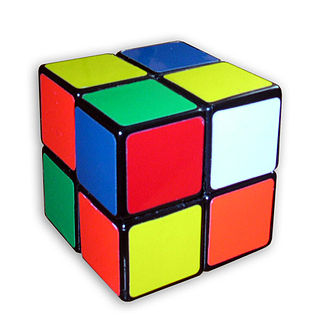
The Pocket Cube is a 2×2×2 combination puzzle invented in 1970 by American puzzle designer Larry D. Nichols. The cube consists of 8 pieces, which are all corners.

The Professor's Cube is a 5×5×5 version of the original Rubik's Cube. It has qualities in common with both the 3×3×3 Rubik's Cube and the 4×4×4 Rubik's Revenge, and solution strategies for both can be applied.
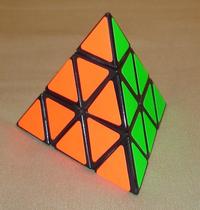
The Pyraminx is a regular tetrahedron puzzle in the style of Rubik's Cube. It was made and patented by Uwe Mèffert after the original 3 layered Rubik's Cube by Ernő Rubik, and introduced by Tomy Toys of Japan in 1981.

The Rubik's Clock is a mechanical puzzle invented and patented by Christopher C. Wiggs and Christopher J. Taylor. The Hungarian sculptor and professor of architecture Ernő Rubik bought the patent from them to market the product under his name. It was first marketed in 1988.
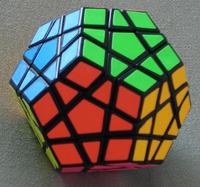
The Megaminx or Mégaminx is a dodecahedron-shaped puzzle similar to the Rubik's Cube. It has a total of 50 movable pieces to rearrange, compared to the 20 movable pieces of the Rubik's Cube.

A Rubik's Snake is a toy with 24 wedges that are right isosceles triangular prisms. The wedges are connected by spring bolts, so that they can be twisted, but not separated. By being twisted, the Rubik's Snake can be made to resemble a wide variety of objects, animals, or geometric shapes. Its "ball" shape in its packaging is a non-uniform concave rhombicuboctahedron.
Leyan Andrew Lo held the world record of 11.13 seconds for the fastest Rubik's Cube solve until Toby Mao in 2006 had a solve of 10.48 at the U.S. nationals competition in San Francisco. Leyan appeared on The Tonight Show with Jay Leno, where he solved a Rubik's Cube in 18.9 seconds. He also holds the former world record for the fastest blindfolded Rubik's Cube solve, at 1:28.82.
Nicolas Hammond is a British Rubik's Cube expert and businessman. He has lived in the US since 1986. He made the world's first Internet banking transaction.
Eric Limeback is a Canadian speedcuber. He is known for his 11/11 3x3x3 multiblindfold Canadian record solve, as well as his standard 3x3x3 blindfolded solving. Limeback was the first Canadian to record a sub-30 second official 3x3x3 blindfolded solve. Limeback began solving the Rubik's Cube in 9th grade. He graduated from Marc Garneau Collegiate Institute in 2010. He formerly held the Guinness World Record for the most 3x3x3 cubes solved in 24 hours, 5800, set from 3–4 October 2013 at Wilfrid Laurier University, Canada.

Feliks Aleksanders Zemdegs is an Australian Rubik's Cube speedsolver. He is one of only two speedcubers ever to win the World Cube Association World Championship twice, winning in 2013 and 2015, and is widely considered the most successful and greatest speedcuber of all time. He has set more than 350 records across various speedcubing events: 121 world records, 214 continental records, and 7 national records.
Anthony Michael Brooks is an American speed cubing champion. He specializes in the 2x2 cube and classic 3x3 cube, and used to be officially ranked in the top five in the world in both categories as recognized by the World Cube Association. Since learning to solve the cube in March 2008, Brooks has become known for developing advanced speedsolving methods as well as frequently promoting speedcubing in the media. While working as the Liberty Science Center's Speedcuber-in-Residence, Brooks set the Guinness World Record for most Rubik's Cubes solved underwater in a single breath, and also led the team that currently holds the world record for solving the Groovik's Cube, the world's largest functioning Rubik's Cube. In July 2017, Brooks was featured on the debut season of FOX's Superhuman TV show.
CubeStormer II is a robot built primarily with Lego Mindstorms and a Samsung Galaxy S2 for solving a Rubik's Cube. The project was commissioned by ARM Holdings and designed and built by Mike Dobson and David Gilday.
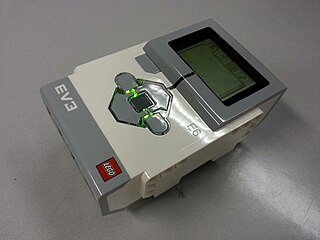
LEGO Mindstorms EV3 is the third generation robotics kit in LEGO's Mindstorms line. It is the successor to the second generation LEGO Mindstorms NXT kit. The "EV" designation refers to the "evolution" of the Mindstorms product line. "3" refers to the fact that it is the third generation of computer modules - first was the RCX and the second is the NXT. It was officially announced on January 4, 2013, and was released in stores on September 1, 2013. The education edition was released on August 1, 2013. There are many competitions using this set, including the FIRST LEGO League Challenge and the World Robot Olympiad, sponsored by LEGO.

CubeStormer 3 is a robot built primarily with Lego Mindstorms and the Samsung Galaxy S4. On 15 March 2014, at the Big Bang fair in Birmingham, England, the CubeStormer 3 broke the previous record, held by its predecessor, the CubeStormer II, for the fastest time to solve a Rubik's Cube. The previous Guinness World Records time was 5.270 seconds. The official time taken to solve the Rubik's Cube by the CubeStormer 3 was 3.253 seconds. This robot was created by inventors David Gilday and Mike Dobson. It took the two of them 18 months to perfect the technology of this robot. The robot was able to conquer the cube by use of four robotic hands. The robot is made out of LEGO and ARM architecture.

Tony Fisher is a British puzzle designer who specialises in creating custom rotational puzzles. He is acknowledged by cubing enthusiasts as a pioneer in the creation of new puzzle designs and new manufacturing techniques. In 2017 the Guinness Book of World Records acknowledged Fisher as the creator of the world's largest Rubik's cube.

Oskar van Deventer is a Dutch puzzle maker. He prototypes puzzles using 3D printing. His work combines mathematics, physics, and design, and he collaborates at academic institutions. Many of his combination puzzles are in mass production by Uwe Mèffert and WitEden. Oskar van Deventer has also designed puzzles for Hanayama.
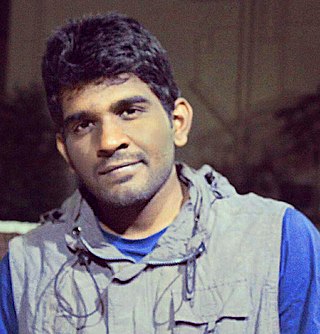
Krishnam Raju Gadiraju is an Indian speedcuber and unicyclist. He is a six-time world record holder and the first Indian to ever set a world record in speedcubing and unicycling.















